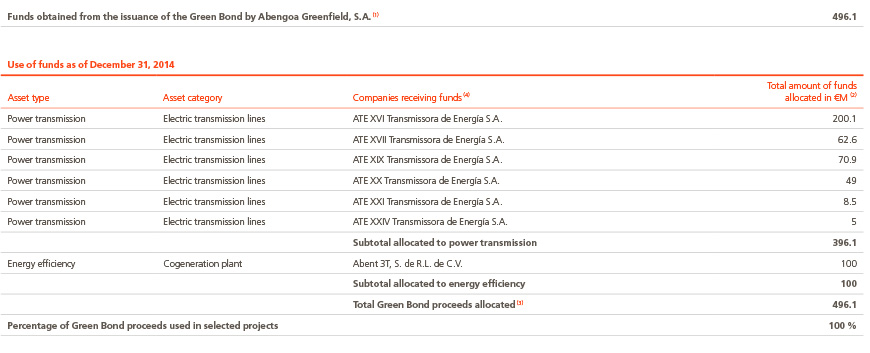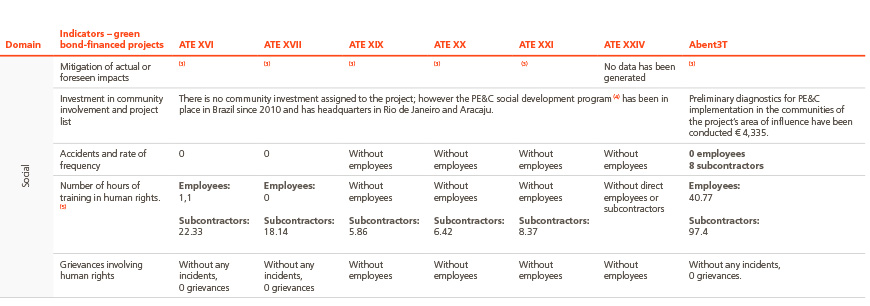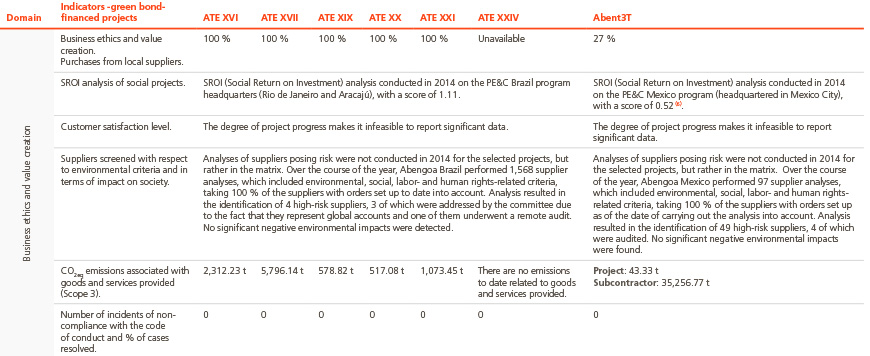Green Bond
Green Bond
Fund allocation indicators (Table 1)

(1) Abengoa Greenfield, S.A. receives net proceeds from bond issuance (USD 296.9 M and EUR 262.3 M) on September 30, 2014.
(2) These projects meet the “Eligible Green Projects” conditions pursuant to the terms under the “Use-of-proceeds” section of the Green Bond issuance memorandum and in accordance with the eligibility criteria approved by Vigeo (European agency dedicated to performance assessment). This entity issued a favorable second opinion with respect to the evaluation of sustainable performance, which is available for consultation on the Abengoa website.
(3) Date of allocation: September 30, 2014 (date on which Abengoa, S.A. uses green bond proceeds to finance, partially or wholly, eligible green projects meeting the environmental, social and corporate governance (ESG) criteria established by Abengoa and Vigeo, as defined in the Preliminary Offering Memorandum dated September 22, 2014 until the long-term financing funds associated with these projects are obtained).
(4) Project companies: (concession companies which own and hold title to a single project) that have received Green Bond proceeds.
List of projects and environmental and social impact indicators (Table 2)
Proceeds from the green bond issued on September 30 have served to finance the seven projects described below. All of these projects meet the aforementioned eligibility criteria which are published in detail on the Abengoa website.

(1) World Energy Outlook 2014 (EA).
(2) Belonging to one of the states through which the transmission line runs.
Responsible management indicators (Table 3)

(1) Direct emissions: Scope 1. Emissions from sources that are either owned or controlled by the company.
(2) Indirect emissions: Scopes 2 and 3. Including emissions resulting from the electricity purchased and used by the company and other emissions that are the consequence of company activities but which are produced by sources that are neither owned nor controlled by the company.

(3) See Appendix C- indicator SO2.
(4) Abengoa’s social development program. Further information can be found in the chapter titled “Connecting with the social environment” and on the Abengoa website.
(5) In relation to subcontractor hours, an estimation was made based on the average number of training hours per subcontracted worker.

(6) SROI assessment will not be performed for the new PE&C headquarters in Tabasco until a year of development has been reached to thereby obtain the degree of maturity needed to undergo evaluation.

(7) Results obtained through the installation-related CSR risk analysis conducted in the latter part of 2014.
(8) In regard to subcontractor hours, an estimation was made based on the average number of training hours per subcontracted worker.
Green Bond Criteria
Green projects eligibility criteria
Green project eligibility criteria include, on the one hand, the “Eligible green project categories” (specified under the “Use-of-proceeds requirements” section of the Second Party Opinion on Sustainability of Abengoa’s “Sustainable Green Bond” issued by Vigeo on September 1, 2014, available on the Abengoa website) and, on the other, the “Environmental, social and governance criteria for green projects” (specified in the “ESG Criteria” section of the Second Party Opinion on Sustainability of Abengoa’s “Sustainable Green Bond” issued by Vigeo on September 1, 2014, available on the Abengoa website).
Protocols and Guidelines for obtaining and monitoring green bondfinanced project indicators
Fund allocation indicators
Project list: list of projects financed used green bond proceeds.
Allocated amounts (in euros): amount obtained by Abengoa Greenfield, S.A. (Issuer of the green bond) and lent permanently to Abengoa, S.A. (Parent Guarantor of the green bond), and which Abengoa, S.A. has used to finance, partially or wholly, eligible green projects meeting the environmental, social and corporate governance (ESG) criteria established by Abengoa and Vigeo, as defined under the Preliminary Offering Memorandum dated September 22, 2014 until the long-term financing funds associated with these projects have been obtained.
Allocation date: date upon which Abengoa, S.A. uses green fund proceeds to partially or wholly finance eligible green projects meeting the environmental, social and corporate governance (ESG) criteria established by Abengoa and Vigeo, as defined under the Preliminary Offering Memorandum dated September 22, 2014 until the long-term financing funds associated with these projects have been obtained.
Environmental and social impact indicators
Contribution to the fight against climate change
CO2 emissions avoided (t CO2eq): greenhouse gas emissions prevented from being released into the atmosphere by the project, establishing for this purpose a comparison between the calculation or estimation (depending on the degree of maturity of the project) of greenhouse gas emissions associated with the project and the energy mix of equivalent technologies in the country of project location.
Contribution to energy transition
Installed capacity, renewable energy source and technology: installed project capacity in MW, in accordance with the project’s technical specifications, and identification of the project’s renewable energy source and technology.
Kilometers of electric transmission lines and number of substations: length in kilometers of electric transmission lines and line substations according to the technical features of the project.
Access to services
Households supplied with clean energy: the number of homes powered as the result of the supply of clean energy generated by the project. The calculation is made by taking average annual consumption per household in the geographical location of the project, with household being understood according to the definition established by the country where the project is located, and the average annual production total of the installation, in accordance with the technical characteristics of the project.
Local economic development
Local jobs generated: the total number of direct local jobs generated during project construction and during project operation. The percentage of locally-hired employees is reported for project execution with respect to the total number of employees hired. Taken into account are two tiers of local employees: those of national origin of the country where the project is being executed, and within this category, residents of origin in territorial and administrative areas where the project is executed and which have sub-state entity, formally defined for the territorial structure of a state.
Responsible management indicators
Environmental dimension
CO2 (tCO2eq) emissions: total direct (Scope 1) and indirect (Scope 2 and 3 emissions are to be taken into account, including emissions linked to supplier goods and services) emissions released into the atmosphere as the result of installation activity. Direct emissions come from sources that are either owned or controlled by the company. Indirect emissions include emissions generated by the electricity acquired and consumed by the project, as well as other emissions that are the consequence of company activities but which occur in sources that are neither owned nor controlled by the company.
Total water consumption and consumption of recycled water (m3): total amount of water consumed by the project, differentiating recycled water consumed from the rest.
Total energy consumption and renewable energy consumption (TJ): energy (primary, electric and thermal) consumed by the project, differentiating between renewable and non-renewable energy.
Total consumption of materials and use of recycled materials (t): consumption by the project of raw materials, differentiating recycled materials used from other materials.
Waste generated and recycled (t): waste generated by the project, differentiating waste that goes on to recycling.
Social dimension
Mitigation of actual or foreseen impacts: potential or actual negative impacts on local communities as the result of project activity, prevention and mitigation measures implemented, and the body affected by said impact.
Investment in social engagement and project list: total investment made in the social engagement actions or activities carried out by the project which are voluntary, non-profit and focused on social or environmental benefit and whose benefits are not restricted to a specific social group. This figure includes:
Donations, non-commercial sponsorships and investment funds in the community where beneficiaries are external to the company.
Operating expenses of permanent social engagement programs or installations.
Accidents and frequency rate: total number of accidents occurring in the project that affect company employees and subcontracted workers and the frequency at which accidents caused by or resulting from work performed occur.
The rate of frequency is the number of accidents occurring for every one million hours worked.
Hours of training in human rights: total number of training hours provided by the company to company employees and subcontracted workers on policies and procedures related to aspects of human rights that are relevant to their activities. Included are courses conducted on the company’s Code of Conduct.
Human rights-related claims and complaints resolved: total number of complaints or claims relating to human rights resolved over the total number of claims and complaints in relation to human rights filed * 100.
Dimension of business ethics and value creation
Purchases from local suppliers: total amount of products and services purchased from locally-based suppliers divided by the sum total of expenditure on procurement of products and services * 100.
A local supplier is understood to be a supplier who has a fixed business base in the country in question, is considered a resident of the same for tax purposes and generates invoices using a tax identification number issued by said country.
SROI assessment of social projects: analyses based on SROI (Social Return on Investment) methodology for gauging the social impact of an investment, enabling computation of the value of outcomes, whether or not these have economic value. The method helps measure the ability to create value of an investment in social engagement programs. The ultimate aim of such analysis is to measure the effectiveness of the PE&C social development programs being carried out to promote social equality.
Referenced:
- The PE&C project in the country of project location included under the GB.
- Social return on investment.
Customer satisfaction level: weighted average with respect to revenues of the customer satisfaction value of each project * 100
Suppliers screened following environmental and society impact criteria: total number of project supplier analyses performed in the area of human rights, labor practices and environmental impact divided and the number of high-risk suppliers identified. Excluded are in-house suppliers within the Abengoa organization.
CO2 emissions associated with supplier goods and services (t CO2eq): total quantity of greenhouse gas emissions generated by project suppliers that are linked to the goods and services supplied.
Number of incidents of non-compliance with the code of conduct and cases resolved: number of incidents of non-compliance with the company Code of Conduct detected, occurring in the project and reported through the internal auditing and control channels, and the percentage of cases resolved.
Corporate governance dimension
Number of issues with high non-compliance and third-party perception risk: number of critical risks (categorized as high risk) detected in the CSR risk analysis performed annually on material Abengoa installations in relation to risks involving non-compliance and/or negative third-party perception.
The assessment is conducted by a personnel committee whose members include the head project manager.
Hours of training in sustainability: total number of hours of sustainability training provided by the company to company employees and subcontracted personnel .
Number of incidents and cases resolved (project control): the number of incidents detected and resolved, occurring in the project and reported through the Abengoa Easy Management project management tool, which gathers all of the information on incidents, cases of non-conformity, actions, initiatives and data recorded in connection with the project, as well as the percentage of cases of resolved incidents.